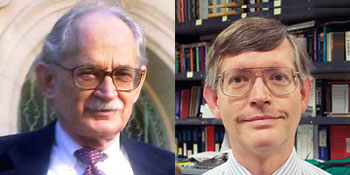博文
2008年Wolf化学奖颁发,Allen Bard 和William Moerner获奖(与催化相关)
|
2008 Wolf prize winners revealed
23 January 2008
US chemists William Moerner and Allen Bard have jointly been awarded the 2008 Wolf Prize for Chemistry, for their pioneering work on single molecule spectroscopy. The $100,000 (£51,000) prize, awarded annually by the Wolf Foundation of Israel, will be presented by Israeli President Shimon Peres in Jerusalem on May 25.
Moerner, based at Stanford University, was selected by the prize committee as the first to achieve optical detection and spectroscopy of individual molecules. Bard was recognised for his parallel work in electrochemical single molecule detection at the University of Texas at Austin.
Interrogating chemical systems and reactions at single molecule resolution gives information that the averaged data obtained from bulk samples often can't provide.
'I was quite surprised to win the award, truthfully - although it's a nice to get the prize,' Bard told Chemistry World. 'The first thing I always think about are all the other people who could have won, and all my colleagues and co-workers, who don't get the credit they deserve.'

|
Allen Bard (left) and William Moerner (right)
|
The Wolf prize committee highlighted Bard's invention of the scanning electrochemical microscope (SCEM) - originally developed in the late 1980s, and now used in fields as diverse as catalysis discovery and single cell analysis. 'We have seen single molecule events at electrodes using SCEM - although it's a very hard experiment,' said Bard.
'The technique uses a very small tip - so in that sense it's a little bit like scanning tunnelling microscopy - but the tip is used as a kind of electrochemical radar to look at a surface below it and get chemical information from it,' Bard explained. Electrochemically activated molecules quickly travel from the tip to the surface, where they react, before returning to the tip, effectively reporting back on the surface structure.
- Allen Bard
'We've used the microscope for a lot of different applications,' said Bard. 'Right now we're trying to discover new electrocatalysts for fuel cells. These devices use catalysts that almost always involve platinum, which has a very high cost. SECM is a very nice way to test arrays of new catalysts - and we've found several good, platinum-free alternatives.' The team are also looking at photocatalysts that could use sunlight to split water, giving hydrogen for fuel.
'I haven't spoken to Bill yet, as I just found out about the prize yesterday,' added Bard. 'But of course I'll celebrate with him in Jerusalem.'
James Mitchell Crow
官方网站介绍:
http://www.wolffund.org.il/cat.asp?id=15&cat_title=CHEMISTRY
相关链接
何谓Wolf奖?
http://www.sciencenet.cn/blog/Print.aspx?id=9593
单分子光谱
single molecule spectroscopy, SMS
单分子吸收光谱法问世
扫描电化学显微镜
scanning electrochemical microscope (SCEM)
Nanonics 扫描电化学显微镜(Nanonics SECM/AFM)
http://www.instrument.com.cn/netshow/SH100758/C27615.htm
所有的扫描探针显微镜都是通过探头顶端所接触的表面进行测试,来获得检测信号,即通过探头顶端所接触的表面进行测试。 在扫描电化学显微镜测试过程中,“超微电极”会靠近接触表面同时产生电活化物质;作为后端接触表面,它既有驱动电化学反应的作用又是“超微电极”与表面距 离指示器。“超微电极”测量的反馈电流主要取决于“超微电极”到表面的距离以及表面电子转移的速度,常常用来监测“超微电极”的逼近方式。
如今,Nanonics研发出针对SECM的独特探针。这是建立在Nanonics微电极所特有的特殊专利:锥形玻璃“包裹” 和悬臂技术的基础之上的;这些微电极可适用于所有Nanonics SPM/NSOM平台并具有独特的光学反馈。平台的突出特点是其光学友好性,能兼容包 括常规拉曼在内的所有光学显微镜系统。能够从底部、顶部及侧面,从各个几何学角度进行光学测量。
https://blog.sciencenet.cn/blog-3913-14911.html
上一篇:【Nature催化文章】Catalytic C–H functionalization by metal carbenoid and nitrenoid ins
下一篇:【Science 催化文章】NMR Imaging of Catalytic Hydrogenation in Microreactors with the U

